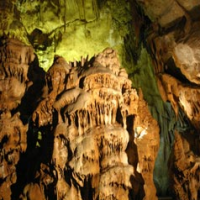Resavska Pećina
Resavska Pećina
The Resavska Pećina cave is in eastern Serbia, in the region of Gornja Resava, 20 km from the town of Despotovac. It is set into the limestone hill of Babina Glava on the fringes of the Divljakovac karst polje, its entrance at 485 m above sea-level. It is one of the oldest caves in Serbia, some 80 million years old, with some of the older formations dating back around 45 million years.
Its formation began before the Great Ice Age through the chemical and mechanical action of a subterranean river running through the limestone bedrock.
The Resava cave was discovered in 1962, although it was known of earlier by shepherds who would shelter with their sheep in the cave in bad weather. It was opened to visitors in 1972. The cave is 4.5 km long, 2830 m have been investigated in detail and around 800 m have been made accessible to visitors. The temperature in the Resava cave is a constant 7°C all year round, with air humidity varying between 80 and 100%.
The interior of the cave abounds in numerous and varied halls, channels, galleries, columns, stalactites, stalagmites, draperies and flowstone waterfalls. The cave formations begin at the very entrance to the cave. The formations came about through the dissolving and precipitation of calcium carbonate, and the colour determined by the minerals through which the water passed. Three colours can be seen, red (from iron oxide), white (from crystalline calcite) and yellow (from the addition of clay).
Visitors move through the cave along a spiral concrete path in one direction, not returning via the same route. The trail passes through various halls, on two levels (the upper and lower galleries). The lowest point reached by visitors is at 405 m above sea level. Four halls can be toured in the upper gallery. The first is the Hall of joined columns or collonades, which got its name from the columns which have merged to connect roof to floor and are composed of yellowish calcite. In the second, the Beehive Hall, the roof is covered with stalactites still in the process of formation. The second and third halls are connected by a tunnel of red breccias which are only found in Serbia in the Resava cave. The Canyon Channel is the driest part of the cave and has no formations. Along the centre of the channel is the 25 m-long Blind Tunnel Swallow-hole, which has been explored but is not adapted for visitors. The Canyon Channel leads to the third hall – the Entrance Hall of History. It was so named because tools have been found there (a stone axe and spear-heads), the skull of an arctic fox and a prehistoric human fireplace. Short tunnels, which were made later, lead to the Path of the Flowstone Waterfalls, where the Organ is also found. The hall is highly acoustic, and features two crystal white sculptures, Grandma and Grandpa. A longer, artificial tunnel leads to the fourth hall, the Crystal Hall, where the cave formations popularly known as the Hung Sheep and Elephant's Foot can be found. There is also a recess in the wall which came about through the merging of a stalactite and stalagmite and is called the Bell or the Cage.
The Resava cave has the status of a protected natural monument and this includes the surrounding area of 11 hectares.
INFORMATION
JP "Resavska pećina"Milosava Zdravkovića - Resavca 4-6, 35213 Despotovac tel: +381 (0)35 611-110www.resavskapecina.rs


Comments
Leave a comment